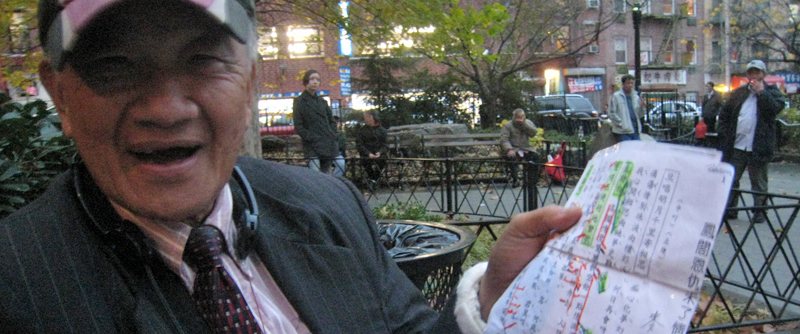2. Life Force in Chinatown
Positive energy reverberates beneath the park’s pavilion as a dozen bodies glide in trance-like, tranquil movements. The bodies are concentrated and controlled, belonging to people of various ages, colors and creeds. Together they mirror the movements of a Chinese man dressed in a silk martial-arts jacket with frog closings. Mr. Jin, as everyone refers to him, has been in the United States only five months, doesn’t speak any English, and how he launched his weekend Tai-Chi classes in Columbus Park his students do not know. For they simply stumbled upon the entrepreneur’s class and joined in for the six hour session (11-5PM) held every Saturday and Sunday, costing them $60 a month.
Tai-Chi is the movement of the body’s life force – or “chi” – through every limb, to keep the body strong, the soul balanced, and the life force agile. Jin teaches the “Chen” style of Tai-Chi, developed by the Chen family in the late 1800’s in the eponymous village of China. Levi Wilson, a 33-year-old Tai-Chi student who also studied Shaolin, Taekwondo, and Hapkido for ten years, describes the Chen style. “It’s a soft martial art with aggressive movements,” he says. “It has its hard and soft points, it’s a constant flow of energy, but punctuated by punches.” At the end of most movements, the students punch, kick, or unsheathe imaginary swords.
Jin was born and raised in Shanghai. He eventually taught three types of martial arts to the Chinese military: Shing-I, Pa Kua, and Tai-Chi. All three styles concentrate on the internal part of the body, the movement and control of one’s chi, and are considered soft martial arts (Neijia). Tai-Chi is unlike hard forms such as Kung Fu and Shaolin, which concentrate on attacks, physical strength and the external body. Tai-Chi is a circular exercise. The meditative, concentrated and physical motions are supposed to, through years of practice, make students sensitive to the movement of their chi and learn how to control the soul.
Most of the students have a hard time understanding their Mandarin-speaking teacher, so Jin overcomes the communication gap by leading his students by physical movement. They stand facing him and do exactly what he does. But, group activities like “pushing hands,” a basic exercise that transfers chi from person to person in a circle, need an English translation to be understood. A one-month-student, Caroll Lin, is the only student who speaks both Mandarin and English. Lin, her round, soft smiling head wrapped in a scarf, translates Jin’s words: “The pushing hands is an exercise to make students forget the instinct to resist force with force.” Instead, the exercise teaches students to yield to force and redirect it. “You need to feel the push and keep it going, ward it off,” she says. A key element of the exercise, Lin explains, is “a gentle exchange of weight and weightlessness.”
While the classes have helped Lin improve her Mandarin, she says that Tai-Chi has done much more for her emotional and physical well-being. “I used to be melancholic,” she says, smiling, “but since Tai-Chi I am not so melancholic.” The students, as a whole, are an enthusiastic lot. Andrew Steinman, a long time Tai-Chi student and Manhattanite, tilts slowly side to side, squats, whisks his arms upwards and then down again. “Oh, man!” he exults. “It keeps you alive – this is how you keep life energy moving through your body, from the toes to the top of your head!”
Class members say they’re like a family, after spending 12 hours together every weekend – learning, growing spiritually, and warding off the cold through their collective movements. “The class forms a community. The seasoned students help the novices,” Lin says. “It’s a community without formality…”
For both practitioners and observers, Tai-Chi is also an art form. Ele Malla, a lanky 17-year-old from Washington Heights, took up martial arts for self-protection. But he soon grew to love it on a different level. “I appreciate the art of the exercise,” he observes. “I use it, not like a painting hanging in a museum that you’ll forget about, but I use the art every day, and I won’t forget that.”
Moving in synch beneath the pavilion, Mr. Jin’s Tai-Chi class does indeed resemble an ephemeral tableau of ancient Chinese performance art, with the vast, unchanging metropolis as its backdrop.

